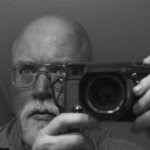
This is a birthday of sorts. It was forty years ago that the Rollei 35 was introduced at Photokina. This camera’s history reminds me just how different things are now compared to when I first started photography in the 1960's. Today, a new compact digital camera is announced, several months later it shows up on shelves and six months later it is replaced by a newer model. The construction of current compact digital and film cameras is overwhelmingly plastic. But that’s okay; you’re expected to buy a newer model within a year, so an enduring build quality is not so important. But a vintage camera is like upscale clocks, watches, and fountain pens. The owner uses a finely-made camera as a tool, and also admires its design, durability, and build quality. In 2006, it is difficult to find anything under $8,000 that is built well to last as long as the owner.
The Rollei 35, like the Rolleiflex TLR, did not have sweeping changes made to it during its 16-year run. There were several different (but same focal length) lenses, the Tessar, the Sonnar, and the Triotar. Changes were made to "modernize" the metering system, ultimately with the use of modern LEDs instead of needles. One model had no meter. And, like Leica and Rolleiflex TLRs, there were the usual pricey commemorative models that are perhaps too garish for actual use. While I haven’t been able to get an authoritative figure, it appears that over two million Rollei 35’s were manufactured. Many are still in circulation. Why was this camera a popular classic?
First, let’s look at what it had going for it.
- The build quality, particularly the earlier models, was good enough to allow decades of trouble-free use.
- Forty years later, you can still get them repaired by some of the independent Rollei repairers like Harry Fleenor.
- When it made its debut, it was the smallest full frame 35mm film camera ever made.
- The lenses are extremely sharp. All perform well at medium apertures (which is all but necessary, for reasons explained below).
- The pressure plate may keep the film flatter than any camera except the Contax RTS (which flattened its film with a vacuum).
- It is excruciatingly cute.
Does all of this come with a price? Of course. Stacking the deck against the Rollei 35 are:
- It has no rangefinder, so you have to estimate the distance to your subject.
- The metering is not TTL (the reading is taken from a small port on the front of the camera) so you cannot use filters without changing the ASA setting each time you change a filter.
- Against all conventions, the film is advanced with your left thumb.
- Against all conventions, the flash shoe is on the bottom. This did solve the problem of shadows below the nose, though.
- Although it is nice and small, it isn’t ergonomically-designed. It is about the size of a pack of cigarettes, and is just as square as one. Add to this that its excellent build quality makes it a bit heavy, and it is particularly prone to be dropped. Rollei tried to help by attaching a wrist strap on one side. Still, when you read descriptions of Rollei 35’s on sale on the Internet or through Ebay, they invariably include a tally of the number and locations of dents on the body.
- The collapsible lens has to be manually extended for use (though pros were already accustomed to this as collapsible Elmars dotted the 35mm Leica landscape for years).
- To change the battery, you have to remove the back and unscrew the metal battery cover with a coin. If you had film in the camera when the battery died, you have to go with a handheld meter, use the sunny 16 rule, or sacrifice the roll.
At first blush, the placement of the meter window and the dials for shutter speed and aperture seem bizarre. Unless you are a Rolleiflex TLR user. To set shutter speed and aperture on a Rolleiflex TLR, you look down at two needles and line them up using two flat dials on the front of the camera, one for film speed and one for aperture. That’s also the way to read the meter and set shutter speed and aperture on the earlier models of the Rollei 35.
The later models of the Rollei 35 replaced the antiquated match-needle meter with more modern LEDs. The battery compartment was transferred to a more convenient location on the top of the camera. To the chagrin of many Rollei loyalists, manufacture of the camera moved from Germany to a plant in Singapore in late 1973. All Rollei 35's were built there until the Singapore plant was closed in 1982. Build quality did not appear to suffer as a result of the move, but collectors still cherish the early German specimens.
Of all the Rollei 35’s peccadilloes, the one that appears to be the most off-putting is the scale focusing. Some people (I include myself) are not particularly good at judging distances in feet or, worse yet, in meters. The best solution to this for me has been to not even try. Instead, using hyperfocal distance makes the camera quite usable.
Hyperfocal distance for a lens is the closest focusing distance at which infinity will still be in focus. The hyperfocal distance differs from focal length to focal length, and it decreases with a decrease in aperture. By decreases, that is to say the hyperfocal distance is fewer feet from the lens with decreasing aperture. Thus, the shorter the hyperfocal length, the more that will be in focus. Lenses with shorter focal length also have a decreased hyperfocal distance. Why is this relevant? If the lens is set at an appropriate hyperfocal setting, you will get the maximum amount of a scene in focus while still keeping distant subjects (i.e., infinity) in focus. This will get you far more near subjects in focus than simply setting your lens at infinity. The Rollei 35 has a 40mm lens. With the aperture set at f/8 and the lens focused at infinity, objects between 22 feet and infinity will be in focus. However, if you focus the lens at the hyperfocal distance, the same scene at the same aperture of f/8 will be in focus from 11 feet to infinity. If you are particularly bad at judging distance, you can set your aperture at f/11 and the focus at hyperfocal distance. That will give you an in-focus field of just under 7.8 feet to infinity. What if you want to photography something about 10 feet away and feel that you can judge that distance halfway correctly? Setting your scale focus on the lens at a guesstimate of 10 feet on the scale at f/11 will give a buffer zone from 6 feet to 27 feet in focus.
As I said, I’m not adept at estimating distances. With a Rollei 35 and 400 ISO film outdoors, I don’t need to be that good. And one does not have to carry around a printed table of hyperfocal distances. It is as easy as setting an aperture of f/8 or f/11 followed by placing the infinity mark (∞) on the lens barrel adjacent to the same aperture value on the base of the lens. There’s no question that the Rollei 35 was not designed to be used as a portrait camera with slow films. If you can live with those limitations, the camera will serve you well as a carry-around or travel companion.
For those interested in playing with hyperfocal distance and field depths for different lenses and apertures, there is an excellent shareware calculator called the DOFMaster that you can download from the web. And it does allow you to print charts for use in the field should you so desire.
For those of you wishing to celebrate Rollei 35’s 40th birthday by buying yourself a gift, used Rollei 35’s are not difficult to find. I favor the early models with the top-mounted meter window instead of LEDs. They may also be easier to repair than the later models, particularly with respect to the meters. While I generally try to find and use the later models of Rolleiflex TLRs, the Rollei 35 apparently started using plastic gears toward the end of their run in Singapore. Some of the folks on the Rollei Users Group like the SE models featuring the faster (f/2.8) Sonnar lenses. But who is going to shoot wide open without a tape measure handy?
 Okay, let's not belabor this review. This is a collection of photographs taken by General George S. Patton. While the author who collected this minimizes Patton's camera as being "simple", the fact is that it was a Leica camera and presumably a Leica lens that was used. So we can't blame the camera for the picture quality. This book is not for photographers. The paper used in publishing is not what you would see in a fine art photography book. This book should be aimed at the Patton aficionado, someone who in interested in the man, not his photographic ability. Military historians may find the book very interesting. The pictures are very poor quality, artistically and technically. If you want a book of war photographs, buy Capa or Nachtwey.
Okay, let's not belabor this review. This is a collection of photographs taken by General George S. Patton. While the author who collected this minimizes Patton's camera as being "simple", the fact is that it was a Leica camera and presumably a Leica lens that was used. So we can't blame the camera for the picture quality. This book is not for photographers. The paper used in publishing is not what you would see in a fine art photography book. This book should be aimed at the Patton aficionado, someone who in interested in the man, not his photographic ability. Military historians may find the book very interesting. The pictures are very poor quality, artistically and technically. If you want a book of war photographs, buy Capa or Nachtwey.






